The impact of lighting systems on the environment and abutters should be assessed in all roadway lighting designs
5.1 Environmental Impacts
Nighttime lighting can impact humans, animals, and plants, both on and off the roadway.
5.1.1 Light Trespass
Light trespass (obtrusive lighting) is defined by three major interrelated elements. The three elements are:
- Spill light: Light that falls outside the area intended to be lit. It is typically measured in lux in a the vertical plane with the light meter oriented towards the light source.
- Glare: Light that is viewed at the light source (luminaire), which reduces one's visibility. Glare is further defined below.
- Sky glow: Light reflected from the light source, road or other surfaces up into the atmosphere. Sky glow in effect reduces one's ability to view stars in the night sky by casting unwanted light into the atmosphere. Though this is not a safety or security issue, groups such as the International Dark-sky Association (IDA) have mounted strong campaigns to reduce sky glow and protect visibility of our night sky.

Figure 18 – Spill Lighting, Glare and Skyglow
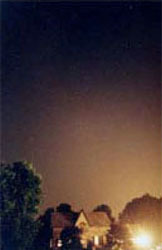
Figure 19 – Example of Skyglow
Maintaining an effective balance between the reduction of light trespass and the provision of quality, beneficial lighting requires thoughtful design and the selection of luminaires with cut-off or full cut-off optical systems. Lighting design with full cut-off optics will typically reduce skyglow and spill lighting. Moreover, it will reduce veiling luminance (glare) from the luminaire on and off the roadway, thus improving overall visibility.
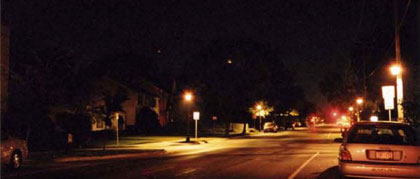
Figure 20 – Example of High Glare Street Lighting
Spill light levels have been developed and are documented in IESNA TM-11 Lighting Trespass: Research, Results and Recommendations and IESNA RP-33 Lighting for Exterior Environments. They are defined in the table below. Designations (LZ1 to LZ4) define the Light Zone and are further defined below. These levels are recommended by the IES where possible. They are typically calculated and measured from the residential boundary line, but are sometimes evaluated from the location of the residence being investigated.
| Designation | Recommended Maximum Illuminance Level (Ee) | |
|---|---|---|
| Pre-Curfew | Post Curfew (Not Applicable to Roadway Lighting) |
|
| LZ 1 | 1.0 lux | 0.0 lux |
| LZ 2 | 3.0 lux | 1.0 lux |
| LZ 3 | 8.0 lux | 3.0 lux |
| LZ 4 | 15.0 lux | 6.0 lux |
Figure 21 – Spill Light Levels
It is important to note that the reduction or elimination of light trespass must never take precedence over the provision of adequate roadway lighting. Lighting the area adjacent to roadway travel lanes (typically within or adjacent to the road right of way) can benefit a driver's peripheral vision. This can also provide better visibility of crossroads, driveways, and sidewalks. Lighting the area adjacent to the road can also help in the detection of large animals that may pose a safety hazard. Balancing the needs of the road user with any potential impacts of the lighting system can be difficult for many roadway types, but the issue needs to be approached holistically.
5.1.2 Lighting Zone Definitions
Lighting zones do not correspond with land use zones. They should be applied with engineering judgment for specific project conditions
Zoning is a well-established practice in community planning. The fundamental idea behind zoning is that it allows a community to determine and regulate appropriate types of use in different areas within its jurisdiction–that is, to define acceptable land uses. Lighting zones work well with land use zones in determining the type and amount of lighting that can be used in different areas.
The choice of an appropriate lighting zone is a matter of judgment based on community priorities for any given area. Among the factors that must be considered are neighborhood ambient conditions, lighting expectations, special environmental concerns, and how interior lighting may affect the exterior environment.
Because identifying the appropriate outdoor lighting zone is a matter of judgment and consensus, there is no automatic means of determining which zone is appropriate for a given area. The same type of lighting application may fall into different lighting zones in different jurisdictions. According to the IESNA Lighting Handbook, the lighting zones are defined as:
5.1.2.1 LZ1 Zone – Low Ambient Lighting
Areas where lighting might adversely affect flora and fauna or disturb the character of the area. The vision of human residents and users is adapted to low light levels. Lighting may be used for safety and convenience but it is not necessarily uniform or continuous. After curfew, most lighting should be extinguished or reduced as activity levels decline.
5.1.2.2 LZ2 Zone - Moderate Ambient Lighting
Areas of human activity where the vision of human residents and users is adapted to moderate light levels. Lighting may typically be used for safety and convenience but it is not necessarily uniform or continuous. After curfew, lighting may be extinguished or reduced as activity levels decline.
5.1.2.3 LZ3 Zone Moderately High Ambient Lighting
Areas of human activity where the vision of human residents and users is adapted to moderately high light levels. Lighting is generally desired for safety, security and/or convenience and it is often uniform and/or continuous. After curfew, lighting may be extinguished or reduced in most areas as activity levels decline.
5.1.2.4 LZ4 Zone - High Ambient Lighting
Areas of human activity where the vision of human residents and users is adapted to high light levels. Lighting is generally considered necessary for safety, security and/or convenience and it is mostly uniform and/or continuous. After curfew, lighting may be extinguished or reduced in some areas as activity levels decline.
5.1.3 Glare
Bright sources of light in the visual field create glare. Light is scattered in the human eye, resulting in a phenomenon known as "veiling luminance." This results in a visual haze within the eye, reducing visibility. Veiling luminance that occurs when bright oncoming headlights significantly reduce one's vision is a common experience. Blocking the bright source or looking away from the visual field reduces the haze associated with veiling luminance, and vision is partially restored.
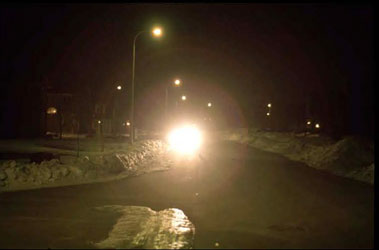
Figure 22 – Example of Glare
The perception of glare, however, varies greatly between observers. The IESNA define glare as "the sensation produced by luminances within the visual field that are sufficiently greater than the luminance to which the eyes are adapted, which causes annoyance, discomfort, or loss in visual performance and visibility. The magnitude of the sensation of glare depends on such factors as the size, position, and luminance of a source, the number of sources, and the luminance to which the eyes are adapted."
Glare typically falls into one of the following categories:
- Disability Glare: The presence of an amount of glare so significant as to prevent an individual from seeing adequately. An example of disability glare is a driver's substantially reduced visibility caused by the headlights of an oncoming car.
- Discomfort Glare: The presence of glare that may over time causes a sense of pain or annoyance, and may increase blink rate or even cause tears.
Disability and discomfort glare are very different phenomena. Disability glare depends on the quantity of light falling on the eye and the angle from the line of sight. With discomfort glare the source luminance is a major factor; with disability glare the source intensity is a major factor. Typically, disability glare will apply to drivers on the roadway, and a numerical ratio has been developed referred to as the veiling luminance ratio which is applied to lighting design as part of IESNA RP-8. Veiling luminance is therefore a key criterion in undertaking lighting design. The effect of veiling luminance on visibility reduction is dependent upon the average lighting level, or average luminance level, of the pavement. A higher level of veiling luminance can be tolerated if the pavement luminance is high. Veiling luminance is calculated in terms of a ratio of the maximum veiling luminance experienced by the observer to the average pavement luminance.
IESNA TM-11 Lighting Trespass: Research, Results and Recommendations observes: "Source brightness had been generally identified as being the principal characteristic to which persons object. Spill light was seen as a less significant effect. It was decided, therefore, to design experimentation to identify quantitatively the relationship between source brightness and the degree to which the light source was found objectionable." Source intensity is a published method of evaluating the off-site discomfort glare. CIE has also produced a document (CIE 150:2003 Guide on the Limitation of the Effects of Obtrusive Light from Outdoor Lighting Installations) that defines limitations for source brightness (intensity) and spill light for outdoor lighting applications. Figure 23 defines source intensity levels. This method will typically be applied where high-wattage light sources such as flood lighting or high mast lights are used. The environmental zone E1-E4 correspond to the lighting zones LZ1-LZ4 described in section 5.1.2.
| Light Technical Parameter | Application Conditions | Environmental Zones | |||
|---|---|---|---|---|---|
| E1 | E2 | E3 | E4 | ||
| Luminous Intensity emitted by luminaires (I) | Pre-curfew: | 2 500 cd | 7 500 cd | 10 000 cd | 25 000 cd |
| Post-curfew hours: | 0 cd* | 500 cd | 1 000 cd | 2 500 cd | |
*NOTE: If the luminaire is for public (road) lighting then this value may be up to 500 cd
Figure 23 – Source Intensity Levels
From the perspective of limiting the impact of a lighting system to both on- and off -road observers, a lighting system meeting the disability glare requirements of AASHTO and IES generally provides the needed control.
5.1.4 Animal and Plant Impacts
Lighting can have impacts on animals as well as humans, particularly since a good deal of animal activity takes place at night. Almost all small rodents and carnivores, 80 percent of marsupials, and 20 percent of primates are nocturnal. Lighting in environmentally sensitive areas with animal activity should minimize the duration, direct the light only where needed, and reduce intensity as much as possible. An example of the impact of lighting on wildlife can be found along the southern Atlantic coast of the United States. Sea turtle hatchlings in this area are genetically programmed to use starlight and moonlight reflections off the water to guide them from their nest to the water. However, man-made light sources can confuse the hatchlings and lead them inland, away from the ocean and on to lighted roadways. Local codes in this region may require the use of full cut-off light sources, controls, and other limitations on exterior nighttime lighting. Another impact to wildlife is the potential for bird strikes to illuminated structures, particularly when they are located along migration routes.
Plants have evolved a wide range of photoreceptors that perceive and respond to light signals in the ultraviolet, blue, red, and near-infrared regions of the electromagnetic spectrum. While there is not a significant body of research to explore and document the specific effects of electric lighting on plant life, there is little doubt that plants are affected in some degree by lighting.
5.1.5 Human Health Impacts
Since the beginning of the 1980's the effect of light on human performance and health has been a point of discussion and research. Disruptions to our circadian rhythms, the pattern of behavioral and physical processes including hormone secretion which is very dependent on light-dark cycles, has been linked to an increased risk to hormone dependent cancers such as breast and prostate cancer (Bartsch et al., 1985) (17). Bartsch also concluded that "melatonin controls not only the growth of well differentiated cancers, but also possesses anti-carcinogenic properties."
Research shows artificial lighting at night could also suppress melatonin (using 2500 lux of white light for between 2 to 4 hours).
The hormones responsible for the circadian rhythm in humans are melatonin, which is released in response to increasing levels of darkness and which promotes sleep, and cortisol, which is the biological opposite of melatonin and an indicator of the level of human activeness.
From an exterior lighting perspective, the question is whether levels and/or certain types of lighting can cause the suppression of melatonin levels at night through light trespass, producing a negative impact on the health of residents. The spectrum of the light can also have an influence, with shorter wavelength lighting having more of an impact. The amount of light needed has to be of sufficient level and applied for a sufficient amount of time to have an effect on melatonin levels.
Research reported in the Journal of Carcinogenesis (18) regarding the impact of light at night on residents from street lighting systems notes: "These light levels rarely exceed 10 lux at the cornea outdoors. Indoors, behind closed curtains, the levels would likely to be much lower. Further, the human eyelids transmit only about 1% to 3% in the short wavelength region of the visible spectrum... Given the available published data on human melatonin suppression in response to light, light trespass through residential windows is an unlikely cause of melatonin suppression, simply because the light levels are so low, particularly with the eyes closed."
Research into these topics is ongoing and not yet conclusive. Thresholds for these non-visual effects are not clearly established at this time. The complexities and interactions, along with the long-term aspects of these issues, make definitive statements elusive.
5.2 Lighting Impacts on the Aging Population
As we age, we are more susceptible to glare. Diseases such as glaucoma can also reduce peripheral vision. This is significant as our population ages and as life expectancy continues to increase. As we age, our eyes deteriorate considerably in their ability to adjust the pupil opening in proportion to the available light. The eye gate becomes smaller and smaller even in the daytime, but the critical feature is the inability to open up at twilight and in darkness to let in whatever little light might be available, particularly past the age of 60 (19).
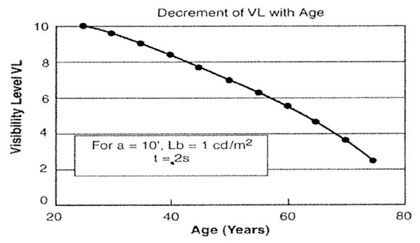
Figure 24 - Reduction in Visibility Level with Age
A vital factor is the ability to see the movement of objects that may represent a hazard from the corner of the eye. It has been found that the ability to see movement 40 and 80 degrees away from the line of sight is reduced as much as 60 percent for people over 60 (19). A younger person can typically see to some degree even with very little light, but this sensitivity to low brightness is reduced to approximately one half at 80+ years of age (19). It has been found that it can take up to 30 minutes for an 85-year-old person to adapt to lower outdoor night- time brightness after having been adapted to the higher interior brightness (19). This long period of eye adaptation can be greatly reduced with roadway lighting.
The visibility factors noted above also apply to pedestrians. Reduced visibility reduces pedestrians' ability to see motor vehicles and avoid crashes. This increases the risk that already exists due to the fact that reaction speed for both the driver and pedestrian is reduced with age.
Installations expecting an increased use by older drivers may consider increasing lighting levels and/or reducing glare
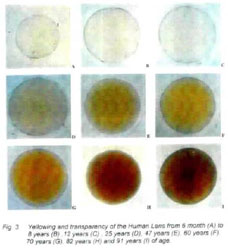
Figure 25 shows the effect aging has on the human eye. As we grow older, the lens becomes discolored (darkens), thus reducing visibility.
Older drivers are also more susceptible to glare. Figure 26 shows that the amount of contrast needed to overcome the driver threshold contrast increases significantly with age. At a light level of 0.5 cd/m2 a 65-year-old driver needs approximately 10 percent more contrast to be able to see an object.
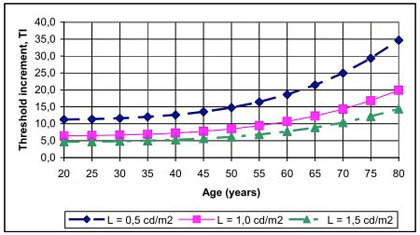
Figure 26 - Impact of Glare and Light Level on the Visibility of Aging Drivers
We do not currently design roadway lighting system with modifiers for age. A designer or agency, however, should be cognizant of the differences between younger and older drivers and may want to consider modifications, either a reduction in the amount of glare or an increase in the lighting levels, if the majority of the road users will be elderly.
